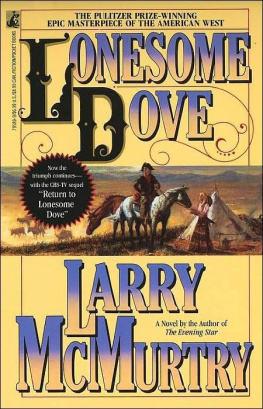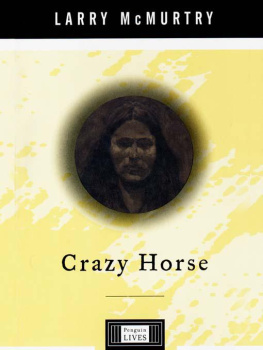
BY LARRY MCMURTRY
Paradise
Boones Lick
Roads: Driving Americas Great Highways
Still Wild: Short Fiction of the American West 1950 to the Present
Walter Benjamin at the Dairy Queen: Reflections at Sixty and Beyond
Duanes Depressed
Crazy Horse
Comanche Moon
Dead Mans Walk
The Late Child
Streets of Laredo
The Evening Star
Buffalo Girls
Some Can Whistle
Anything for Billy
Film Flam: Essays on Hollywood
Texasville
Lonesome Dove
The Desert Rose
Cadillac Jack
Somebodys Darling
Terms of Endearment
All My Friends Are Going to Be Strangers
Moving On
The Last Picture Show
In a Narrow Grave: Essays on Texas
Leaving Cheyenne
Horseman, Pass By
BY LARRY MCMURTRY AND DIANA OSSANA
Pretty Boy Floyd
Zeke and Ned

Larry McMurtry


TOUCHSTONE
Rockefeller Center
1230 Avenue of the Americas
New York, NY 10020
www.SimonandSchuster.com
Copyright 2001 by Larry McMurtry
All rights reserved,
including the right of reproduction
in whole or in part in any form.
First Touchstone Edition 2002
TOUCHSTONE and colophon are registered trademarks
of Simon & Schuster, Inc.
For information about special discounts for bulk purchases,
please contact Simon & Schuster Special Sales:
1-800-456-6798 or business@simonandschuster.com
Designed by Katy Riegel
Map by David Cain
Paul Gauguin panels reproduced courtesy of
Runion des Muses Nationaux/Art Resource, New York
Manufactured in the United States of America
1 3 5 7 9 10 8 6 4 2
Library of Congress Cataloging-in-Publication Data
McMurtry, Larry.
Paradise / Larry McMurtry
p. cm.
1. McMurtry, LarryJourneysOceania. 2. McMurtry, LarryHomes and hauntsTexas, West. 3. Novelists, American20th centuryBiography. 4. Texas, WestSocial life and customs. 5. OceaniaDescriptions and travel. 6. McMurtry, LarryFamily. 7. Family, Texas, West. 8. McMurtry family. I. Title.
PS3563.A319 Z469 2001 2001020568
831.54dc21
[B]
ISBN 0-7432-1565-6
ISBN-13: 978-0-7432-1566-4
eISBN-13: 978-1-4516-0860-1
0-7432-1566-4 (Pbk)
Includes an excerpt from Roads copyright 2000 by Larry McMurtry

To Sara

I
My Parents and
Polynesia


I AM IN PUNAAUIA, Tahiti, in a thatched bungalow with a twenty-foot ceiling. My bungalow sits at the end of a clattery wooden walkway, built over Punaauias perfect blue lagoon. The South Pacific, here in its gentlest mode, laps a few feet below my bed. In effect I sleep on the most soothing of water beds, one whose blue waters slap and sigh, untrapped.

THE ARTIST PAUL GAUGUIN lived in Punaauia for a short time in the 1890s, on the second of his forays into Tahitian life. Earlier, not long after he had arrived in the Society Islands for the first time, hoping to scare up some portrait work, a disturbing thing had happened. One night, while waiting for Paul to return from an errand in town, his young Tahitian mistress, Tehaamana (sometimes spelled without the apostrophe, sometimes spelled Tehura, or in other ways), grew terribly frightened of the night spirits. Since the time of Bougainville and Cook, Tahitian women had been prized for their quiet ease, their serenity of soul; but Tehaamanas serenity had deserted her on this night. She was then thirteen or fourteen, a young girl living with a Frenchman three times her age, grown fearful, suddenly, in the deep tropical darkness.
It is doubtful that Paul Gauguin, a French artist with little reputation and less money, newly arrived from Europewhere he had left his Danish wife and their five childrenwas the ideal person to allay Tehaamanas terrors; but at least her fear made a deep impression on him. He painted what amounts to a note about it, an oil called Manao Tupapau (Spirit of the Dead Watching)now in the Albright-Knox Gallery in Buffalo, New Yorkin which we merely see a scared girl lying facedown on a bed. But Gauguin soon followed this up with a whole series of variants on the scene, focusing now on Tehaamanas innocence, rather than just her fear. These studiesin pen and ink, in pastel, in woodblock, in transfer drawings, and in oilshe called Parau na te varua ino (Words of the Devil); he insisted on keeping the title in Tahitian, to the puzzlement and irritation of the Parisians who were expected to buy these strange works. In the pastelon the front cover of this bookTehaamana, a startled young girl, realizes she has lost something. Too late, she covers herself. The sun sets quickly in the tropics; no less quickly, innocence goes. In the oil, though (on the back cover)it is in the National Gallery, in WashingtonTehaamana is smiling a mysterious, Evelike smile; its the blue devil behind her who is in some sort of blank-eyed shockpussywhipped, it may be. This quiet, smiling young woman has somehow bested the devil; she will go on to become the imposing woman in two of Gauguins greatest portraits: Vahine no te tiare (Woman with a Flower) and Vahine no te vi (Woman with a Mango); in the latter she is pregnant. Gauguin, as he is uneasily aware, has taken a child to wifedoes he have her, or does she have him? When he is not making love to Tehaamana he is drawing her, sketching her, painting her, hoping that the mystery of his young Eve will reveal itself to his eye or submit to his line.
In some of Gauguins later work his Eves have faces like fish, as if he is pursuing the problem of innocence back to an earlier life stage. Does Tehaamana have no knowledge, or does she have too much? Paul Gauguin was still worrying that question when he died, much as the aging Yeats worried in Leda and the Swan:
Being so caught up,
So mastered by the brute blood of the air,
Did she put on his knowledge with his power
Before the indifferent beak could let her drop?
Paul Gauguin knew many women, but it is doubtful if any one of them left as deep a mark on his art as Tehaamana, betrothed to him by her parents when she was thirteena young girl who lived in paradise.

I HAVE COME to the same paradiseTahitia place whose beauty neither writers nor painters nor mariners have ever managed to overstate, in order to think and write about my parents, Hazel and Jeff McMurtry: there they are, as a young couple, in the frontispiece to this book. The whole of their forty-three-year marriage was spent well inland, in Archer County, Texas. Many people like Archer County, and a few people love it, but no one would be likely to think it an earthly paradise.
Next page











